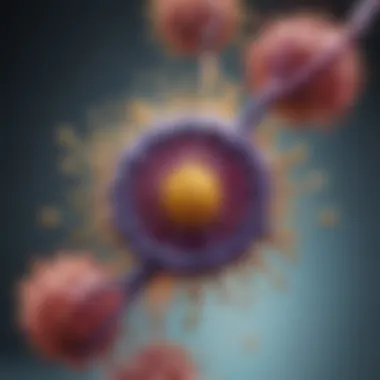Exploring the Uses of Immune Globulin in Medicine


Intro
Immune globulin represents a pivotal component in modern medicine, functioning as a therapeutic agent with wide-ranging applications. This section intends to set the stage for a thorough exploration of immune globulin, evaluating its roles in treating various health conditions and its underlying mechanisms. Understanding immune globulin's significance provides insight into its indispensable part in both clinical and research settings.
Immune globulin, primarily derived from pooled human plasma, contains a high concentration of antibodies. These antibodies play a crucial role in bolstering the body's immune response. The diverse applications of immune globulin can be categorized to include treatment for immune deficiencies, autoimmune disorders, and certain infections. With the increasing prevalence of immunocompromised patients and chronic illnesses, the relevance of this subject is heightened.
In the sections that follow, we will delve into the scientific basis and methodologies behind its use, examining how it is administered and the effects it can have on patient outcomes. Furthermore, we will discuss the considerations that practitioners must keep in mind when employing immune globulin therapeutically.
This comprehensive overview aims to serve as a resource for students, researchers, educators, and professionals. It seeks to clarify the complexities of immune globulin and promote a deeper understanding of its critical role in therapeutic practices.
What is Immune Globulin?
Immune globulin plays a crucial role in medical therapies, particularly for patients with various immune-related conditions. It is a blood product derived from human plasma that contains antibodies. The use of immune globulin is essential for treating certain diseases and maintaining immune function. Understanding its definition, composition, and different types offers insights into its significant therapeutic applications.
Definition and Composition
Immune globulin refers to a group of proteins in the blood that function as antibodies. These antibodies are proteins that help defend the body against infections and diseases. The composition of immune globulin primarily includes immunoglobulin G (IgG), alongside other immunoglobulins. IgG makes up the majority of antibodies in circulation and is vital for immune responses. This complex mixture is usually pooled from thousands of donors to ensure a broad spectrum of antibodies.
Types of Immune Globulin
Immune globulin comes in various types, each designed for specific medical uses. Understanding these types aids in recognizing their applications and potential benefits in therapeutic contexts.
Intravenous Immunoglobulin (IVIG)
Intravenous Immunoglobulin (IVIG) is administered directly into the bloodstream. The primary advantage of IVIG is its rapid absorption and wide distribution throughout the body. This method is particularly beneficial for treating conditions such as primary immunodeficiencies and certain autoimmune disorders. Key characteristic of IVIG is its ability to provide immediate immune support. However, the administration requires a healthcare setting, and potential risks include allergic reactions and headaches.
Subcutaneous Immunoglobulin (SCIG)
Subcutaneous Immunoglobulin (SCIG) involves injecting the immune globulin under the skin. This method is often more convenient for patients, as it can be done at home after proper training. SCIG allows for a steadier level of immunoglobulin in the bloodstream over time. It is often recommended for patients who may not tolerate IVIG well or prefer self-administration. The unique feature of SCIG is the patient empowerment it provides, allowing for more flexible treatments. On the downside, injection site reactions may occur.
Specific Immune Globulin
Specific Immune Globulin is targeted for particular infections. For example, rabies immune globulin is specifically used post-exposure to rabies virus. Its use is crucial in situations where quick protection against a specific pathogen is required. The main characteristic of Specific Immune Globulin is its tailored composition that enhances protection against certain infectious diseases. This type is particularly valuable in clinical emergency settings. However, its use is limited to specific indications, stressing the need for accurate diagnosis and timely administration.
Mechanism of Action
Understanding the mechanism of action of immune globulin is essential for grasping its role in various medical contexts. Immune globulin, a crucial component of immunity, works primarily by modulating the immune system, neutralizing pathogens, and enhancing the overall immune response. Each of these functions contributes significantly to the therapeutic applications of immune globulin, especially in treating immune deficiencies and autoimmune diseases.
Immune Modulation
Immune modulation refers to the ability of immune globulin to modify the immune system's activity. By altering immune response pathways, immune globulin can help reestablish balance in the immune system. This is particularly important in conditions where the immune response is either insufficient or overactive.
For instance, in autoimmune diseases, the system mistakenly attacks healthy cells. Immune globulin can help to reduce this inappropriate response, providing relief to the patient. Studies indicate that intravenous immunoglobulin therapy reduces inflammatory markers and might restore normal immune function in some autoimmune conditions. Thus, the modulation aspect of immune globulin is vital as it not only supports immune deficiencies but also helps to recalibrate the immune response in autoimmune disorders.
Neutralization of Pathogens
Neutralization of pathogens is another fundamental mechanism by which immune globulin exerts its effects. When pathogens such as viruses and bacteria enter the body, immune globulin binds to these pathogens. This binding prevents pathogens from attaching to host cells and facilitates their removal from circulation by immune cells.
For example, in the case of acute infections like Hepatitis A, immune globulin can provide immediate protection by neutralizing the virus before it causes significant harm. The quick action of immune globulin is essential for individuals whose immune systems are compromised, as they often lack the ability to mount an effective response against infections. Research has shown that timely administration of immune globulin in such cases can substantially reduce the severity of disease and speed up recovery.


Enhancing Immune Response
Enhancing the immune response is a crucial function of immune globulin therapy. Immune globulin contains antibodies that provide passive immunity, which is particularly beneficial for patients who cannot synthesize their own antibodies. By administering immune globulin, healthcare providers can boost the recipient's antibody levels, helping the body to mount a stronger defense against infections.
In situations involving chronic diseases, where the natural immune response is impaired, immune globulin plays a significant role in enhancing patient outcomes. For instance, in patients with chronic inflammatory demyelinating polyneuropathy, immune globulin therapy can lead to improved strength and function. This enhancement mechanism is vital for many conditions, proving that immune globulin is not just a support tool, but an essential part of active treatment.
Immune globulin serves as a powerful ally in navigating complex medical conditions by modulating immune functions, neutralizing harmful pathogens, and enhancing the immune system's responsiveness.
Clinical Applications
The concept of clinical applications for immune globulin is crucial since it highlights the multitude of therapeutic uses of this biological product. Immune globulin therapy has demonstrated efficacy in various medical areas, offering potential benefits to patients with distinct conditions. Understanding these applications aids healthcare providers in selecting the appropriate treatment pathways for individual patients. The therapeutic versatility of immune globulin speaks for its relevance in modern medicine.
Primary Immunodeficiency Disorders
Patients suffering from primary immunodeficiency disorders often struggle with recurrent infections due to a lack of functional immune response. Immune globulin provides an essential source of antibodies for these individuals, effectively augmenting their immune defenses. Administering immune globulin in such cases can lead to improved health outcomes, decreasing the frequency and severity of infections. Clinicians consider factors such as the severity of the immunodeficiency and the patient's history of infections when deciding on immune globulin therapy.
Autoimmune Diseases
Autoimmune diseases arise when the body's immune system mistakenly attacks its own tissues. Immune globulin plays a significant role in modulating this aberrant immune response. It can help alleviate symptoms and improve the quality of life for patients.
Guillain-Barré Syndrome
Guillain-Barré Syndrome is characterized by rapid-onset muscle weakness due to autoimmunity. In this context, immune globulin therapy serves as a beneficial treatment option. It works by inhibiting further immune damage to the nervous system. The key characteristic of Guillain-Barré Syndrome is its acute nature, making immediate treatment necessary. Recognizing immune globulin as a viable intervention is vital in reducing long-term disability.
Myasthenia Gravis
Myasthenia Gravis is an autoimmune neuromuscular disorder, leading to varying degrees of skeletal muscle weakness. The treatment of this condition often involves immune globulin therapy. It helps in decreasing autoantibody levels and enhancing neuromuscular transmission. A key characteristic is its potential for rapid improvement in symptoms, which is particularly advantageous in acute exacerbations. Nonetheless, the response to treatment can vary among patients, which may pose a challenge during management.
Neurological Disorders
Immune globulin is also applied in the management of certain neurological disorders. These conditions often involve autoimmune processes that can benefit from immunotherapy.
Chronic Inflammatory Demyelinating Polyneuropathy
Chronic Inflammatory Demyelinating Polyneuropathy is characterized by progressive weakness and sensory loss. Treatment often includes immune globulin, which can lead to gradual improvement in symptoms. The disease's unique feature is its chronicity, often necessitating long-term management strategies. Benefits of immune globulin include its relative safety profile compared to other immunosuppressive therapies.
Multiple Sclerosis
Multiple Sclerosis is another neurological disorder that may benefit from immune globulin administration. It helps to modulate the immune response and reduce relapse rates. A key attribute is its multifaceted nature, addressing both relapsing and progressive forms of the disease. However, the long-term effectiveness may vary, and ongoing research is necessary to optimize treatment strategies.
Infectious Diseases
Immune globulin is indispensable in treating certain infectious diseases, offering passive immunity when necessary.
Hepatitis A
In cases of Hepatitis A exposure, immune globulin provides immediate passive immunity, helping to prevent the infection. Its rapid effect is crucial, especially for travelers or those in outbreak situations. Key characteristics include its effectiveness when administered within a short time frame after exposure. Limitations involve its inability to treat active infection, underscoring the need for cautious timelines.
Rabies
Rabies is a life-threatening virus, where immune globulin serves a critical role in post-exposure prophylaxis. Administering immune globulin alongside the rabies vaccine is vital. Its unique feature is the combination of both passive and active immunization. This approach enhances the likelihood of successful outcomes, but timely administration is essential for maximizing efficacy.


Post-Exposure Prophylaxis
Post-exposure prophylaxis with immune globulin can be life-saving in various scenarios. For instances of potential high-risk exposure, such as rabies, this approach helps mitigate the risk of disease establishment. Understanding the guidelines for administration and timing is essential for healthcare providers to ensure optimal patient care.
Administering Immune Globulin
Administering immune globulin is crucial in the practical application of this therapy. The method of administration impacts efficacy and patient experience. Understanding the routes of administration and the specific dosage allows healthcare providers to tailor treatments to individual patient needs, ensuring optimized outcomes. Furthermore, considerations regarding timing and frequency are essential for maintaining the effectiveness of the treatment while mitigating the risk of side effects.
Dosage and Administration Routes
IVIG Administration
IVIG, or intravenous immunoglobulin, is a common method for administering immune globulin. One significant aspect of IVIG administration is its ability to deliver high doses of antibodies directly into the bloodstream. This method provides rapid absorption and systemic distribution, making it a preferred choice for urgent therapeutic needs.
The key characteristic of IVIG administration is the dosage. High-dose IVIG therapy can range significantly, depending on the condition being treated. For example, in cases of primary immunodeficiency, a typical dosing schedule may involve an initial high dose followed by maintenance doses every three to four weeks. This regimen not only promotes therapeutic levels of antibodies but also ensures that patients maintain functional antibody responses over time.
A unique feature of IVIG is its potential to prompt a more immediate immunomodulatory effect compared to other forms of administration. However, this effectiveness can come with certain disadvantages. Patients may experience side effects like headaches, chills, or infusion reactions, which can be concerning. Monitoring during and after infusion is, therefore, essential to manage these potential complications effectively.
SCIG Administration
Subcutaneous immunoglobulin (SCIG) is another route for administering immune globulin. This method features the administration of smaller doses of immunoglobulins into the subcutaneous tissue rather than directly into the bloodstream. The specific aspect remians how SCIG allows for more gradual absorption than IVIG, thus contributing to a steadier level of antibodies in circulation over time.
A notable characteristic of SCIG is the convenience it offers. Patients can often self-administer SCIG, promoting independence and better adherence to treatment regimens. This feature has made SCIG increasingly popular among patients who prefer at-home treatments.
However, while SCIG has advantages such as fewer severe infusion reactions and more consistent immunoglobulin levels, it is not without drawbacks. Some patients report local site reactions, including discomfort at the injection site. Additionally, the need for multiple subcutaneous injections may deter some individuals from choosing this method.
Timing and Frequency of Infusions
The timing and frequency of immunoglobulin infusions play a pivotal role in the overall effectiveness of treatment. Healthcare providers typically develop individualized schedules based on clinical response and the specific condition being treated. For example, some patients may require infusions every two to four weeks, while others may have a more prolonged regimen based on their response.
Thus, ensuring consistent administration aligned with patient needs is fundamental to achieving optimal health outcomes while balancing the potential for adverse effects. Regular evaluation and adjustment of treatment schedules further enhance the therapeutic efficacy.
Potential Side Effects
Understanding the potential side effects of immune globulin therapy is critical for both patients and healthcare providers. These reactions can influence treatment decisions and patient compliance. Recognizing what to expect can help in managing any adverse events effectively.
Common Reactions
Common reactions to immune globulin administration are generally mild and self-limiting. Patients might experience:
- Headaches: One of the most frequent complaints, headaches can occur shortly after administration.
- Fever: A low-grade fever may develop as the body responds to the infusion.
- Nausea: Some individuals may feel nauseous, although this is less common.
- Fatigue: Feeling tired or fatigued post-infusion can also happen but typically resolves quickly.
Most of these common side effects do not necessitate discontinuation of therapy, but they highlight the need for proper monitoring during and after infusion.
Serious Adverse Effects
While severe reactions are rare, it is important to be aware of them. These can have significant implications for patient safety and treatment outcomes.
Anaphylaxis


Anaphylaxis is a rare but life-threatening allergic reaction that can occur after immune globulin administration. This reaction is crucial to mention due to its immediate danger. Symptoms may include:
- Difficulty breathing
- Swelling of the face, lips, or throat
- Rapid heartbeat
- Dizziness or fainting
Anaphylaxis poses a unique challenge in the context of immune globulin therapy. It is essential for patients to be monitored, particularly during their first exposure. This potential for serious reaction underscores the need for preparedness in any clinical setting where immune globulin is used.
Kidney Damage
Kidney damage is another significant potential risk when using immune globulin. Renal complications can arise, especially in individuals with existing kidney issues. Key aspects include:
- Risk Factors: Certain medical conditions, such as diabetes and medical histories of kidney problems, can elevate the risk.
- Monitoring: Regular monitoring of kidney function is necessary to identify any early signs of damage.
- Hydration: Maintaining proper hydration during treatment can mitigate this risk.
Kidney damage highlights an important consideration in the management of immune globulin therapy. Awareness and proactive strategies can ensure better outcomes for patients, minimizing the potential for serious kidney-related complications.
In summary, being informed about the potential side effects of immune globulin can empower patients and healthcare providers alike. Knowledge leads to better management, ensuring safe and effective therapy.
Understanding these side effects is key to utilizing immune globulin effectively in therapeutic practices.
Considerations and Contraindications
The section on considerations and contraindications is vital when discussing immune globulin treatment. Not every patient is suitable for this therapy, and understanding these nuances is crucial for healthcare providers. Proper assessment ensures both safety and efficacy in administering immune globulin. Therefore, this part emphasizes the importance of careful patient evaluation and outlines the scenarios in which immune globulin should not be used.
Patient Assessment
Before initiating treatment with immune globulin, a thorough patient assessment is essential. This assessment helps to identify factors that may affect the patient's response to therapy. Key elements in this evaluation include medical history, current health status, and specific immune disorders. The following considerations must be made during the assessment:
- Comorbid Conditions: Evaluation of other existing medical conditions is important. Certain diseases may complicate treatment, necessitating additional precautions.
- Previous Reactions: Understanding a patient's history with immune globulin or similar therapies can indicate possible risks of adverse reactions.
- Laboratory Tests: Conducting relevant blood tests can determine levels of immunoglobulin and assess any underlying immune deficiencies.
A comprehensive evaluation allows healthcare providers to tailor the treatment plan, ensuring maximum benefit while minimizing risks.
Contraindications
There are specific contraindications that must be reviewed before the use of immune globulin. These contraindications serve to protect patients from potential harm. Some of the primary contraindications include:
- Hypersensitivity Reactions: Patients with a known allergy to any component of immune globulin should not receive the treatment, as it may lead to severe reactions.
- Severe Immunodeficiency: Individuals with certain conditions that severely compromise their immune system may not benefit from immune globulin therapy, making caution essential.
- History of Thrombosis: Patients with a previous history or risk of thromboembolic events should be evaluated carefully, as immune globulin can increase the risk of thrombosis due to increased blood viscosity.
- Certain Autoimmune Disorders: Individuals suffering from specific autoimmune conditions may face adverse effects with immune globulin therapy, necessitating a different treatment approach.
It’s essential that healthcare professionals remain vigilant in assessing each patient's suitability for immune globulin therapy to prevent complications and ensure optimal outcomes.
In summary, both patient assessment and clear understanding of contraindications are paramount in determining the appropriateness of immune globulin therapy. These considerations not only promote patient safety but also enhance the overall effectiveness of treatment.
Future Directions in Research
Research on immune globulin continues to advance, with a focus on enhancing its therapeutic applications across various medical fields. Understanding future directions in research is vital for improving treatment efficacy and expanding the range of conditions that immune globulin can address. These innovations may lead to better patient outcomes and the refinement of existing therapies.
Innovations in Immunoglobulin Therapy
Innovative approaches in immunoglobulin therapy seek to enhance the effectiveness and safety of treatments. One significant area of focus is the development of new formulations of immune globulin that may provide more consistent and reliable responses in patients. These formulations aim to reduce the frequency of administration while maintaining or increasing efficacy.
Additionally, advances in biotechnological methods are paving the way for creating engineered immunoglobulin molecules. These engineered variants could target specific pathogens or modulate immune responses more precisely, potentially reducing side effects associated with traditional therapies. The integration of nanotechnology into immune globulin formulations is also being explored, which could improve bioavailability and delivery mechanisms for patients, particularly those with challenging conditions.
Clinical Trials and Developments
Clinical trials remain a cornerstone of advancing knowledge in immune globulin therapy. Ongoing trials examine the effects of immune globulin in various populations, aiming to gather data on its effectiveness in treating conditions beyond those currently approved. For instance, researchers are investigating the timing and dosage variations to optimize therapeutic regimens for autoimmune diseases and infections.
Moreover, collaborations between pharmaceutical companies and academic institutions are crucial in exploring the broader potential of immune globulin. These partnerships can accelerate research and facilitate innovative trial designs. The commitment to understanding the pharmacokinetics and pharmacodynamics of immune globulin will help clarify the best ways to use these therapies in clinical practice.
In summary, the future of immune globulin research holds promise. Innovations in immunoglobulin therapy and robust clinical trials can expand its utility, addressing the ever-evolving landscape of patient needs.



